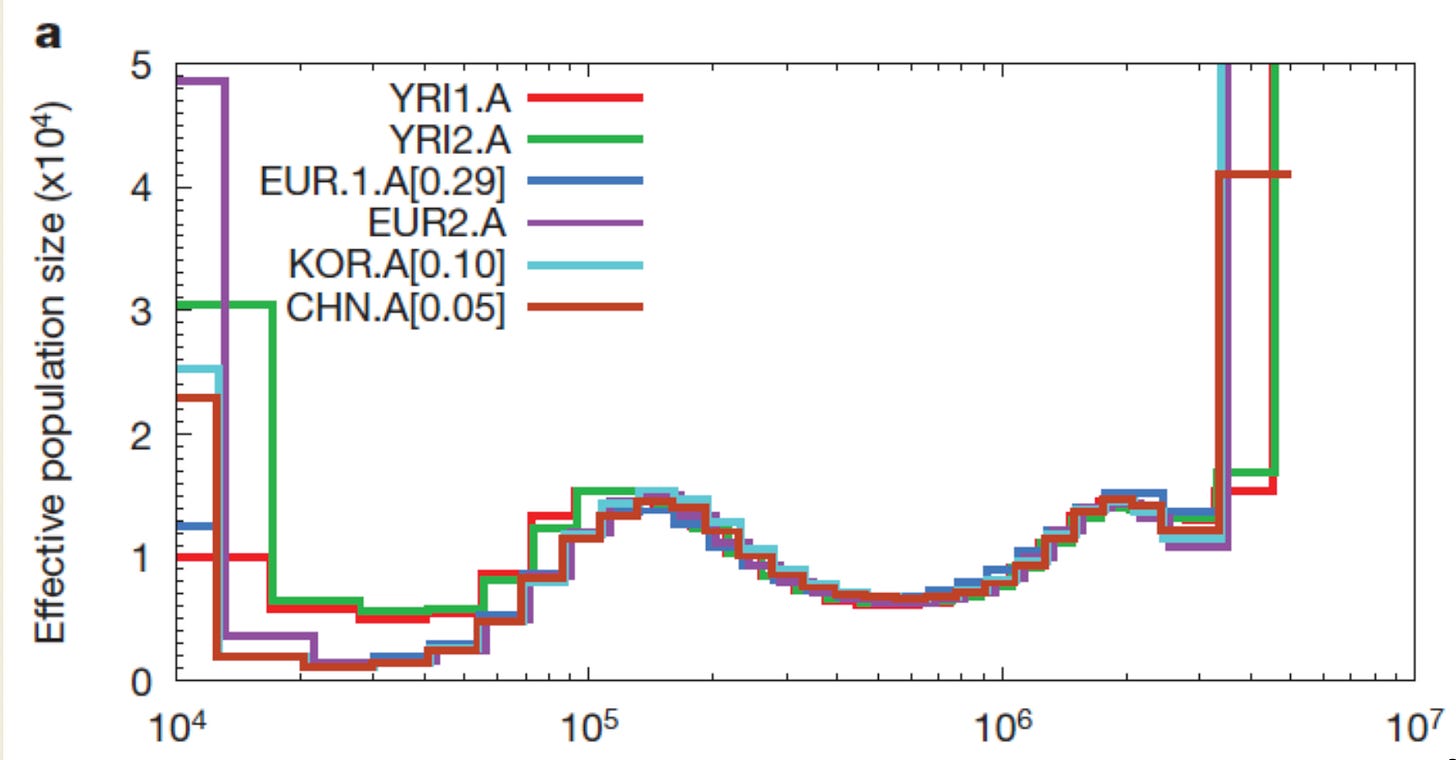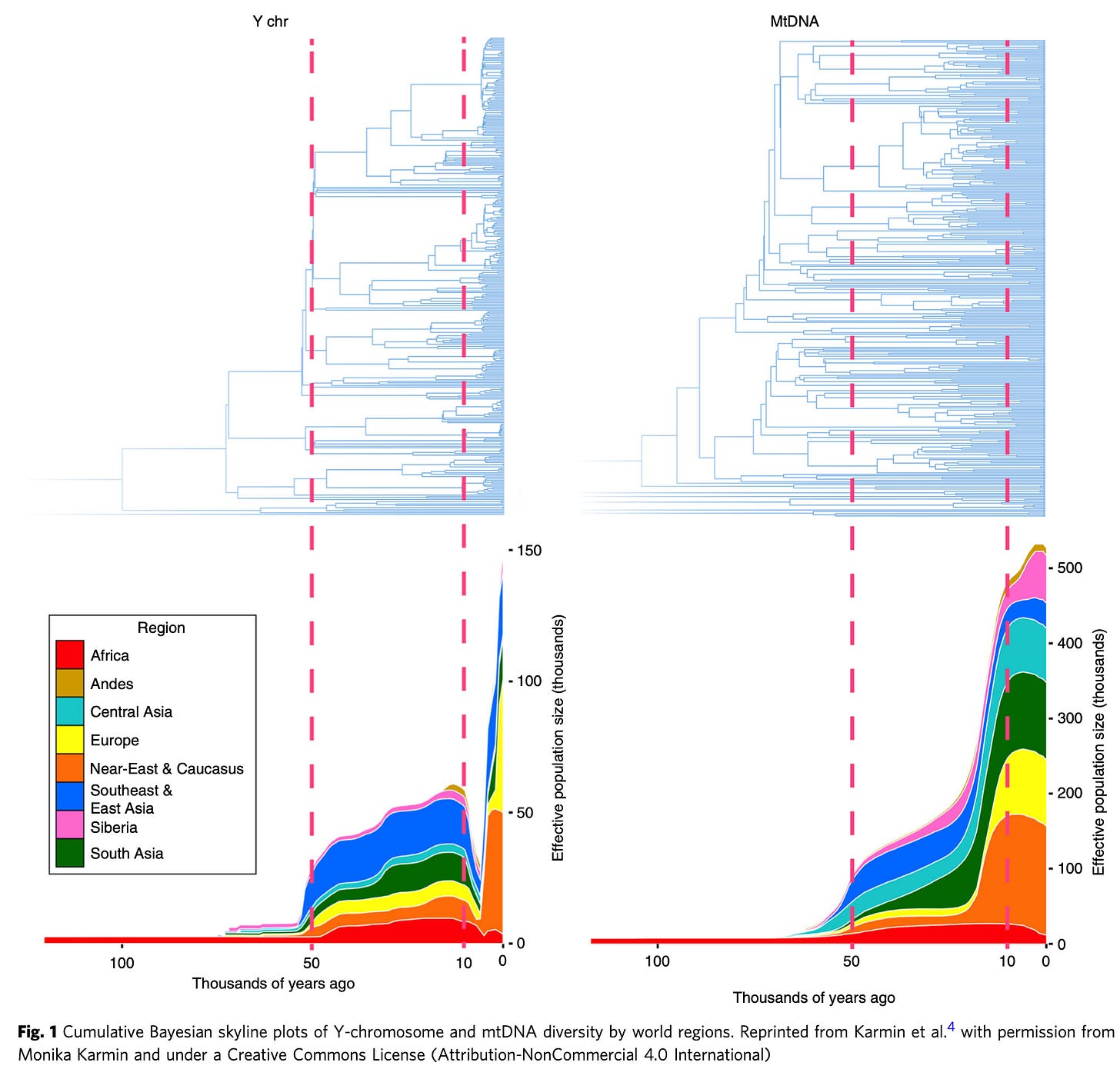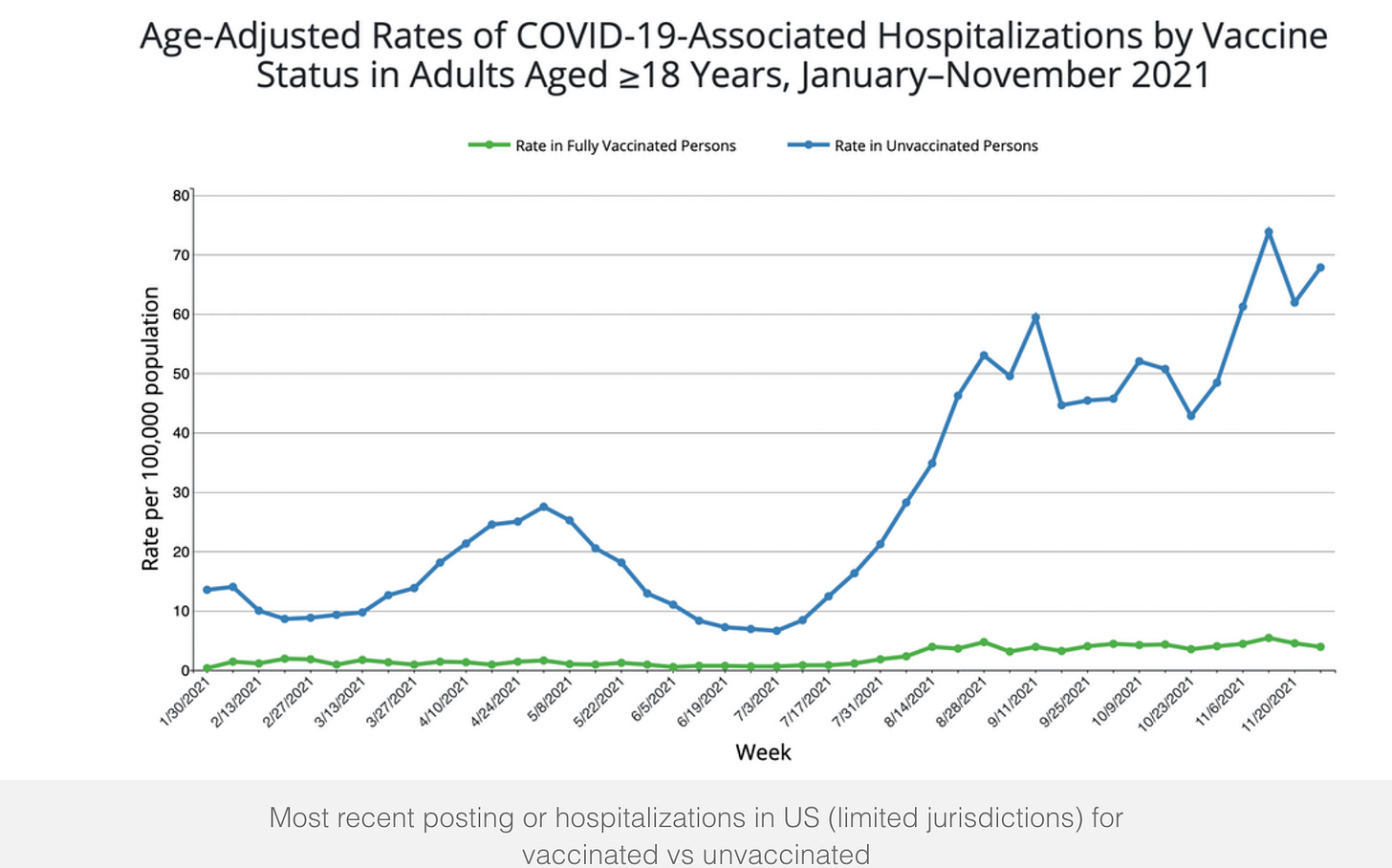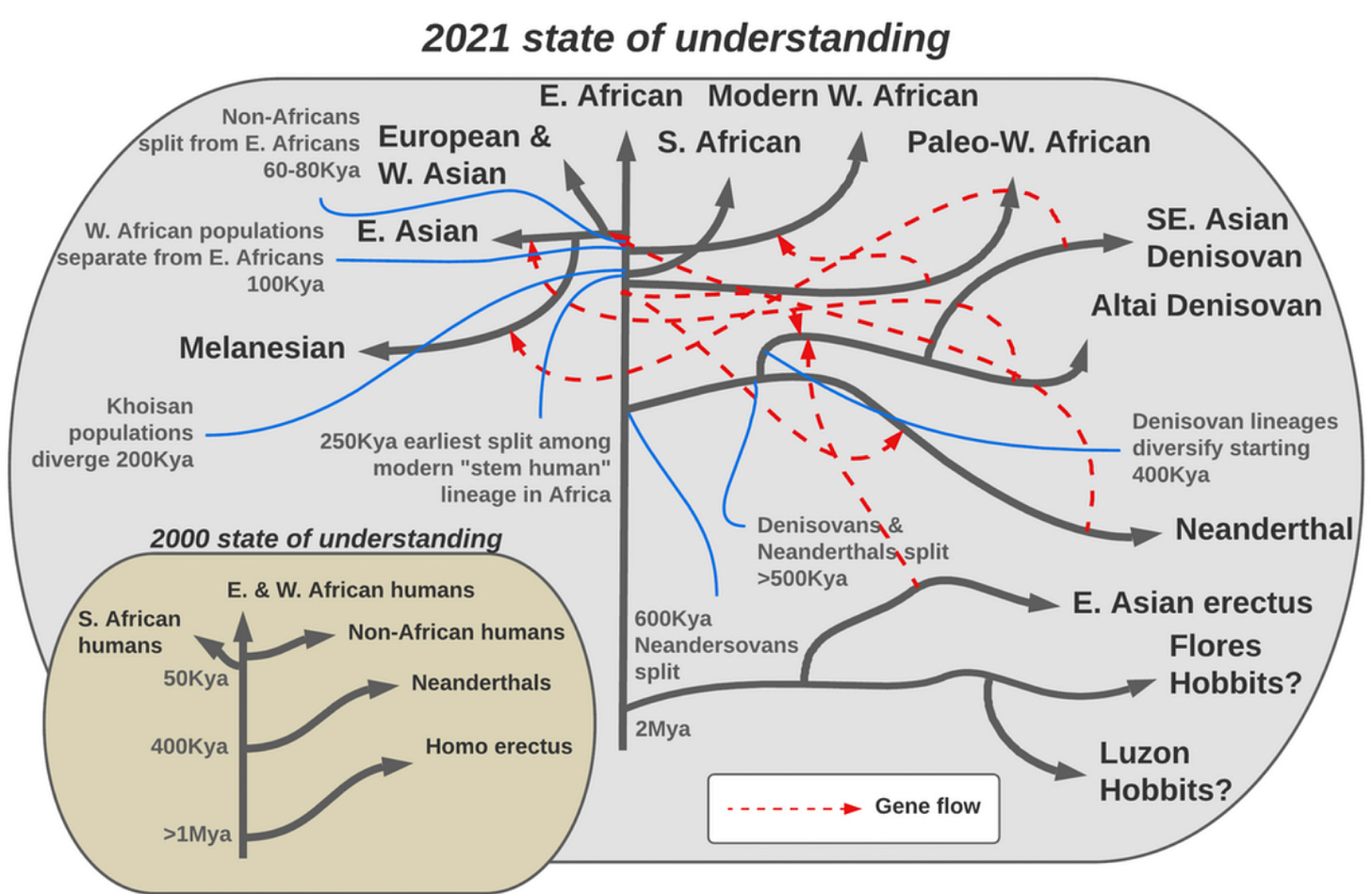First: High Patriarchy
Tian Chen Zeng, Alan J. Aw, & Marcus W. Feldman: Cultural Hitchhiking & Competition Between Patrilineal Kin Groups Explain the Post-Neolithic Y-Chromosome Bottleneck <https://www.nature.com/articles/s41467-018-04375-6.pdf>; M. Karmin & al. (2015): A Recent Bottleneck of Y Chromosome Diversity Coincides with a Global Change In Culture (Genome Res. 25, 459–466) <https://pubmed.ncbi.nlm.nih.gov/25770088/>:
All of us (men) have y-chromosomes that are those of Y-Chromosome Adam back roughly some 200,000 years ago, with whatever mutations of that have occurred since. Looking at the ensemble of y-chromosomes allows us to construct a tree by virtue of which y-chromosomes differ by one base pair, which by two, and so on. The amount of branching at each calculated date in the past tells us what the effective population size (of men) was then, for each y-sperm that fertilizes an egg is another chance for mutations to occur.
Similarly, all of us have mitochondria that are those of Mitochondrial Eve, back some back roughly some 200,000 years ago, with whatever mutations of that have occurred since. Looking at the ensemble of mitochondria allows us to construct a tree by virtue of which mitochondria differ by one base pair, which by two, and so on. The amount of branching at each calculated date in the past tells us what the effective population size (of men) was then, for each fertilized egg is another chance for mitochondrial mutations to occur.
Note that between out-of-Africa and the coming of agriculture—between 50 and 10 thousand years ago—the effective male population size was 30,000 at the start and 60,000 at the end of that late-Mesolithic Age: 30,000 and 60,000 of the men alive back then have living descendants today. By contrast, the effective female population size was more like 100,000 50 thousand years ago and more like 450,000 10 thousand years ago.
But then, with the invention of agriculture, things go bonkers. Mitochondrial lines continue to multiply at a furious pace as mutations happen. Y-chromosome lines… sharply slow down in their multiplication, as the men’s side of the effective population crashes. At the trough, 5 thousand years ago, the men who have living descendants today amount to only 1/20 as large a fraction as the fraction of women alive then who have living descendants today.
This would seem to mean that -8000 to 1 saw substantial polygyny for a few men, and non-reproduction for others. It also means the inheritance of male reproductive advantage: that if your great-grandfather had the resources to have more than one wife, the odds were higher that you were at the top of the inequality pyramid and had the resources to have more than one wife as well. Patriarchal reproductive inequality was in that age both substantial and inherited.
This is polygyny: one man, many wives—and lots of men with no wives and little sexual access to women. This is the Biblical Patriarch Jacob: 13 children with two wives and two concubines. Jacob and Leah's children were Reuben, Simeon, Levi, Judah, Issachar, Zebulun, and Dina; Jacob and Rachel's children were Joseph and Benjamin; Jacob and Zilpah's children were Gad and Asher, and Jacob and Bilhah's children were Dan and Naphtali. And somewhere in the neighborhood there were three men—unnamed, possibly dead—who were without wives, and without children.
Leah, Rachel, Zilpah, and Bilhah's mitochondrial DNA lineages were passed down. The three nameless men's y-chromosome lineages were not: only Jacob's was.
Maintaining polygyny for a number of generations requires great social pressure and great societal inequality among men. It also requires a great deal of subservience among women. Back then, women were, to a substantial degree, property: the property of their fathers, and then of those in the patriarchal polygynous network who gained control over them. And back then, a great many men were without resources‚ for the overwhelming majority of men would, if they had resources to deploy to attain any form of social power, would have chosen to use those resources to marry. And yet many of them could not do so. How much social power had to be deployed against them, and in what form, to enforce their non-marrying?
This age of super-patriarchy stands out in our genetic record. The social structures and institutions to support it are not there before -8000 and do not persist since the year 1.
What was human life and human inequality like back in this patriarchal age? What brought it on? What made it come to an end?
And what was life like for women in those years—because making women share husbands is something that requires a lot of social power deployed and exerted to enforce?
One Video:
Flashmob Nürnberg 2014: Ode an die Freude <https://www.youtube.com/watch?v=a23945btJYw>:
One Picture:
Very Briefly Noted:
David Wickert & Greg Bluestein: Inside the Campaign to Undermine Georgia’s Election<https://www.ajc.com/politics/election/georgia-2020-election-what-happened/>
Tian Chen Zeng, Alan J. Aw, & Marcus W. Feldman: Cultural Hitchhiking & Competition Between Patrilineal Kin Groups Explain the Post-Neolithic Y-Chromosome Bottleneck: ‘Our hypothesis is consistent with current… archaeogenetics… and is important for conceptions of cultural and social evolution in prehistory… <https://www.nature.com/articles/s41467-018-04375-6.pdf>
Yasemin Saplakoglu (2018): Why Do Genes Suggest Most Men Died Off 7,000 Years Ago?: ‘Warfare between patrilineal clans could have caused this so-called “Y chromosome bottleneck”…. The researchers did “careful computer simulations, whereas the previous papers had not,” said Chris Tyler-Smith… <https://www.livescience.com/62754-warring-clans-caused-population-bottleneck.html>
TV Tropes: Filibuster Freefall: ‘The phenomenon was first noted by author James Nicoll on the rec.arts.sf newsgroup and dubbed “The Brain Eater” (not to be confused with the trope about eating brains) in relation to authors Poul Anderson and James P. Hogan… <https://tvtropes.org/pmwiki/pmwiki.php/Main/FilibusterFreefall>
Jared Diamond (1999): The Worst Mistake in the History of the Human Race: ‘The advent of agriculture… a watershed moment…. It may also have been our greatest blunder… <https://www.discovermagazine.com/planet-earth/the-worst-mistake-in-the-history-of-the-human-race>
Priya Anand: Tech’s Return to Office Plans Get Pushed Back En Masse<https://www.bloomberg.com/news/newsletters/2021-08-09/tech-s-return-to-office-plans-get-pushed-back-en-masse?cmpid=BBD122921_TECH>
Zachary D. Carter: I Thought I Knew Harry Reid. I Was Wrong: ‘The pol I once scoffed at for embodying the worst of American politics turned out to be one of the most morally effective leaders the Democratic Party has ever seen… <https://www.politico.com/amp/news/magazine/2021/12/30/harry-reid-democratic-party-leader-526259>
Addison Del Mastro: New and Old #3: ‘“The Single-Staircase Radicals Have a Good Point”… Henry Grabar…
Paragraphs:
Ian Cuttress: CPU Year In Review 2021: Efficient Cores Are The New Bling: ‘Back in the world of desktop silicon, Intel launched its 12th Generation Alder Lake processors in November, marking the first time in a long while that Intel has launched two generations in the same year… Intel 7 process node (renamed from 10ESF)… performance cores and efficiency cores…. This requires strong collaboration with Microsoft… as this hybrid design is tightly coupled to the operating system…. Intel has only launched the high-performance parts so far, the i9-K, i7-K, and i5-K, with the rest to come…. Alder Lake was seen as a win for new Intel CEO Pat Gelsinger, offering key performance in more realistic scenarios than AMD, at a similar or better price point…. The big excitement is going to come when Intel showcases the rest of the Alder Lake family in the New Year… L
INK: <https://www.anandtech.com/show/17135/cpu-year-in-review-2021-efficient-cores-are-the-new-bling>
Debby Wu: How Chip Shortages Helped Define 2021: ‘In 2021, users of everything from iPhones and PlayStations to cars and ultrasound machines were jolted awake to a new reality: All these things need silicon chips, and there aren’t enough of them…. Why can’t suppliers just make more?… Silicon manufacturing is a time-consuming and expensive venture. Building a chip fabrication plant takes at least two to three years and can easily cost $10 billion or more…. “Real men have fabs,” Advanced Micro Devices Inc. founder Jerry Sanders once famously said. He was talking about companies, but this year, world leaders got the memo too…
Tim Snyder: USSR 1922–1991, USA 1776–2025?: ‘the West won the cold war: a combination of elections, markets, the welfare state, and labor unions that allowed social mobility and a sense of the future…. Since the 1980s… throwing away most of our advantages… weakening a system that once looked formidable and attractive. It would be best to notice this while we still have some time to do something about it…. We should not be congratulating ourselves. We should be asking ourselves what we have done wrong these last thirty years, and thinking about how to end our own stagnation. We should be preparing for the crisis looming in 2025…
LINK:
Manu Saadia: ’It’s like their lives are a perpetual persecution. All the while they have no public healthcare nor public education to speak of, and they’re grifted upon by unctuous pastors and right-wing extremists—who line their pockets with the fear they stoke. I don’t understand this country and when I read stuff like this I realize that the only benefit in understanding America is to avoid getting killed by all these fascist yahoos. Amazing that these goons are still aggrieved that people scorn them for voting for that degenerate. And that’s after the failed coup attempt…
LINK:

Adam Gurri: No Solutions: ‘It does not take much for technologists to become technocrats. When you work chiefly in a domain which has expanded humanity’s capabilities in a palpably measurable way in your lifetime, it becomes very easy to think nearly all of life’s problems can be solved by adopting a similar stance…
LINK:
Nicole Barbaro: The Black Men of Harvard ‘63: ‘Back in Kent Garrett’s day, thought, the Harvard class of 1963 had just 1.5% Black men… enrolling 18…. In The Last Negroes at Harvard: The Class of 1963 and the Eighteen Young Men Who Changed Harvard Forever, Kent Garrett and Jeanne Ellsworth recount Garrett’s years as a Harvard undergraduate…. What stood out to me about the racial politics of the day as described and experienced by Garrett, were some of the striking similarities to current racial debates…
LINK:
Matthew Yglesias: Human History in the Very Long Run: ‘It’s mostly pretty bad…. Our species is about 300,000 years old, and farming and towns started about 12,000 years ago. The vast majority of the history of human technology unfolded before the existence of our species, and the vast majority of our species’ existence was prior to permanent settlements…. It was really only starting 200 or 300 years ago that we see any kind of sustained upward momentum in living standards…. The neolithic revolution—when people turned to agriculture—was also a big deal. The problem is that, as Jared Diamond and now many other scholars seem to agree, agriculture made living standards lower rather than higher…. What’s nuts to me, though, is that this whole agricultural era is just so damn short in the context of human history…. The good news is that by having a settled lifestyle, you can accumulate possessions. The bad news is all your stuff can be stolen…. T the creation of a surplus-extracting exploiter class…. The industrial revolution in the North Atlantic world and then the spread of prosperity due to decolonization and globalization after 1960 or so are basically the best things that ever happened…
LINK:
PAID SUBSCRIBER ONLY Content Below:
An outtake from this semester’s “History of Economic Growth” course, as the topic has not yet gelled in my mind at all?
The Family[?] of Humanity
I think that there is one substantial thing wrong with this picture of our current (very shaky) understanding of recent human evolution:
There are not enough of the dotted-red “gene flow” lines: there should be gene-flow everywhere. Paleo-West Africans surely mated in substantial numbers with modern West Africans. The Khoi-San South African population mated with both East and West Africans. West Africans mated with Europeans and East Africans, East Africans mated with West Africans and West Asians, and everybody descended from the founding population that moved across the Red Sea in the last out-of-Africa world-diffusion migration mated not just with one another as people moved back-and-forth across Eurasia, but mated with the Neanderthals and Denisovans they found where they were going—and then people came back to Africa as well, and mated. People are people. Exogamy is a very powerful force. And the seas are not that wide, the mountains not that high, the deserts not that wide. Thus “divergence” is a term of great art here: it is that populations become separate enough that gene-flow between them is materially slower than gene-flow within them.
But there is gene-flow.
And that tells us that there was considerable commonality in the shared mental universes and in the understanding of pair-bonding and gift-exchange protocols among the gene-flowers. You get a lot more gene-flow out of wooing than out of rape-and-run, which is highly likely to be a very lifespan-limiting move in most places and at most times before the development of an extractive military caste.
Razib Khan has some interesting observations here:
Razib Khan: Yo Mama’s Mama’s Mama’s Mama… etc.: ‘In 2000, we had the tidy and elegant story of a single East-African tribe 60,000 years ago that exploded… destined to push aside all…. In 2021, the story is no longer either tidy nor elegant…. The mtDNA tree reflects… that Eurasians, Australians and Amerindians probably emerged out of a single original population with a homeland somewhere in Africa. As that tiny subsample of humans left Africa, they underwent a series of bottlenecks that reduced our lineage’s genetic variation…. But… non-African modern humans… [and] Neanderthal[s]… Denisovan[s]…. [And] within Africa… [we have to] modify the simple idea that all modern humans descend from a single “East-African tribe”…
LINK:
The belief that there was one East African population that, less than 80,000 years ago, acquired a set of mutations—biological and cultural—that then gave them a sufficient edge to crowd all of their cousins out of their niches worldwide is now much harder to maintain. Yes, the existence of the “uncanny valley” phenomenon may mean that sometimes our ancestors and their close cousins interacted very violently when they came upon one another. But the gene-flow does point to shared mental universes:
Razib Khan: Our African Origins: The More We Understand, The Less We Know: ‘Multiple hearths of modern human development within Africa…. The development of modern human physical characteristics didn’t occur in a singular moment in a specific place… evolved gradually over hundreds of thousands of years in different locales and ecologies…. Features… arose in one location, only to spread to other regions over time through interbreeding… evolutionary experiments across many populations loosely linked by avenues of gene flow…
LINK:
Khan’s conclusion:
Razib Khan: What Happens in Denisova Cave Stays in Denisova Cave… Until Now: ‘Denisovans and Neanderthals… descended from an out-of-Africa migration more than 600,000 years ago…. Humans outside of Africa all carried 2–3% Neanderthal heritage, the people of New Guinea also harbored as much… Denisovan… 3–4%…. Southeast Asia is just good ape habitat, period. And during the Pleistocene, those apes included humans…. Neanderthals and Denisovans were humans… just like us…. Humans meet other humans, and no matter how different the strangers, somehow they inevitably tend to end up… getting it on…
LINK:
Yet all of this gene flow coexists with DNA-clock evidence of substantial population bottlenecks at not cheetah level, but still extraordinarily low levels:

Frankly, I do not understand how this could be. I find myself thinking very dark thoughts about culture-gene coevolution—how your genes come from a predominate source but many other sources, but how cultures grow on their own, and then clash violently way back in human history. If you are on the losing end, you are lucky if only your men die (save for a few who are assimilated). But you may all die if resources seem scarce, and if some jacked-up charismatic figure says that the Storm God of the Semites demands it:
And Saul smote the Amalekites from Havilah until thou comest to Shur, that is over against Egypt. And he took Agag the king of the Amalekites alive, and utterly destroyed all the people with the edge of the sword. But Saul and the people spared Agag, and the best of the sheep, and of the oxen, and of the fatlings, and the lambs, and all that was good, and would not utterly destroy them: but every thing that was vile and refuse, that they destroyed utterly.
Then came the word of the LORD unto Samuel, saying: “It repenteth me that I have set up Saul to be king: for he is turned back from following me, and hath not performed my commandments.” And it grieved Samuel; and he cried unto the LORD all night. And when Samuel rose early to meet Saul in the morning, it was told Samuel, saying, “Saul came to Carmel, and, behold, he set him up a place, and is gone about, and passed on, and gone down to Gilgal.”
And Samuel came to Saul: and Saul said unto him, “Blessed be thou of the LORD: I have performed the commandment of the Lord.”
And Samuel said, “What meaneth then this bleating of the sheep in mine ears, and the lowing of the oxen which I hear?”
And Saul said, “They have brought them from the Amalekites: for the people spared the best of the sheep and of the oxen, to sacrifice unto the LORD thy God; and the rest we have utterly destroyed.”
Then Samuel said unto Saul,” Stay, and I will tell thee what the LORD hath said to me this night.”
And he said unto him, “Say on.”
And Samuel said, “When thou wast little in thine own sight, wast thou not made the head of the tribes of Israel, and the LORD anointed thee king over Israel? And the LORD sent thee on a journey, and said, ‘Go and utterly destroy the sinners the Amalekites, and fight against them until they be consumed.’ Wherefore then didst thou not obey the voice of the LORD, but didst fly upon the spoil, and didst evil in the sight of the LORD?”
And Saul said unto Samuel, “Yea, I have obeyed the voice of the LORD, and have gone the way which the LORD sent me, and have brought Agag the king of Amalek, and have utterly destroyed the Amalekites.” But the people took of the spoil, sheep and oxen, the chief of the things which should have been utterly destroyed, to sacrifice unto the LORD thy God in Gilgal.
And Samuel said, “Hath the LORD as great delight in burnt offerings and sacrifices, as in obeying the voice of the LORD? Behold, to obey is better than sacrifice, and to hearken than the fat of rams. For rebellion is as the sin of witchcraft, and stubbornness is as iniquity and idolatry. Because thou hast rejected the word of the Lord, he hath also rejected thee from being king.” 1 Samuel 15:7-23
Cultures giving us our extraordinary collective powers to survive, flourish, and spread. And our cultures being enormous threats not just to the lives but to the gene-lines of our neighbors.
We have been doing the “culture” thing for a long time—it has been the time-binding anthology-intelligence fitness-multiplier that we have evolved to be a suitable platform for:
Joseph Henrich (2015): The Secret of Our Success: How Culture Is Driving Human Evolution, Domesticating Our Species, & Making Us Smarter (Princeton: Princeton University Press) <https://www.google.com/books/edition/The_Secret_of_Our_Success/HFHpCAAAQBAJ>: ‘Gesher Benot Ya'aqov has yielded rich insights into the life of one society around 750,000 years ago. The extensive remains indicate the existence and persistence of hearths and areas for both stone-tool manufacturing and food processing. The inhabitants controlled fire and made a variety of stone tools, including hand axes, cleavers, blades, knives, awls, scrapers, and choppers. Made from flint, basalt, and limestone, tool manufacture was done on-site, often from giant slabs carried in from a distant quarry by a team. Some of the basalt slabs have notches, indicating the use of levers as part of the quarrying process. The basalt is of the highest quality and well quarried, suggesting that someone had a storehouse of know-how on the topic.
The inhabitants of Gesher Benot Ya'aqov also, somehow, obtained freshwater crabs, turtles, reptiles, and at least nine types of fish, including carp, sardines, and catfish. Some of these fish were big, longer than a meter. On top of this, there were seeds, acorns, olives, grapes, nuts, water chestnuts, and various other fruits. This bounty included the submerged prickly water lily, which grows well away from shore. It also appears that they were cracking nuts open and roasting acorns to remove their shells and perhaps reduce the bitter tannins. They may even have made “popcorn” by roasting the seeds from the prickly water lily, as has been done for thousands of years in India and China.
Clearly, cumulative cultural evolution is up and running at this point, generating more know-how than you, me, or our lost European Explorers could have ginned up in a lifetime. If you aren’t sure, go quarry some high-quality basalt slabs (you’ll need a lever, I think), make a beautiful hand axe with full symmetry (remember to make that antler or bone hammer first), bring down an elephant…
There is all this. And there is also dealing with the fact that we are all descended, in the male lines at least, from people who not only did not study war no more, but studied war so intensively that they got very, very good at it—that is profoundly disturbing on many levels.













This analysis dovetails nicely with this excellent post by Dr. Alice Evans, titled "10,000 Years of Patriarchy": https://www.draliceevans.com/post/ten-thousand-years-of-patriarchy-1
The connections between agricultural practices and the rise of patriarchy are nicely elucidated.
I'm pretty confident that the polygyny explanation is correct, but I'm wondering if there's another possible explanation. We know that the transition to farming led to much poorer health for the farmers, including substantial decreases in average height. Is it possible that the now-smaller women had both poor nutrition during pregnancy and a much greater likelihood of dying in childbirth? This would reduce the number of successful live births per each female and increase the number of women necessary to produce the same number of male children who survived to reproduce.
To make this clear, suppose each farming woman gave birth to just one male child who survived to reproduce, compared to a hunter-gatherer woman who produced 3 such male children. That would account for the "extra" women in 5000 years b.p. compared to 10,000 years b.p.